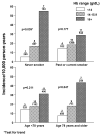Late-life hemoglobin and the incidence of Parkinson's disease
- PMID: 20709430
- PMCID: PMC3006667
- DOI: 10.1016/j.neurobiolaging.2010.06.023
Late-life hemoglobin and the incidence of Parkinson's disease
Abstract
Brain iron promotes neurodegeneration in Parkinson's disease (PD). While hemoglobin (Hb) is the most abundant source of peripheral iron in humans, its relationship with PD is uncertain. This report examines the association between Hb in late life and PD incidence. From 1991 to 1993, Hb was measured in 3507 men in the Honolulu-Asia Aging Study. Men were aged 71-93 years and without PD. Participants were followed until 2001 for incident PD. Hb levels declined markedly with age. For men aged 71-75 years, 14.8% had levels < 14 g/dL versus 53.6% in those aged 86 and older (p < 0.001). During follow-up, 47 men developed PD (19.8/10,000 person-years). After age adjustment, PD incidence rose significantly from 10.3 to 34.9/10,000 person-years as Hb increased from < 14 to ≥ 16 g/dL (p = 0.024; relative hazard 3.2; 95% confidence interval, 1.2-8.9). Associations persisted after accounting for early mortality and adjustments for concomitant risk factors. While Hb declines with advancing age, evidence suggests that Hb that remains high in elderly men is associated with an increased risk of PD.
Copyright © 2012 Elsevier Inc. All rights reserved.
Figures
References
-
- Abbott RD. Logistic regression in survival analysis. Am J Epidemiol. 1985;121:465–471. - PubMed
-
- Abbott RD, Petrovitch H, White LR, Masaki KH, Tanner CM, Curb JD, Grandinetti A, Blanchette PL, Popper JS, Ross GW. Frequency of bowel movements and the future risk of Parkinson’s disease. Neurology. 2001;57:456–462. - PubMed
-
- Abbott RD, Ross GW, White LR, Tanner CM, Masaki KH, Nelson JS, Curb JD, Petrovitch H. Excessive daytime sleepiness and subsequent development of Parkinson’s disease. Neurology. 2005;65:1442–1449. - PubMed
-
- Abbott RD, Launer LJ, Rodriguez BL, Ross GW, Wilson PWF, Masaki KH, Strozyk D, Curb JD, Yano K, Popper JS, Petrovitch H. Serum estradiol and risk of stroke in elderly men. Neurology. 2007;68:563–568. - PubMed
-
- Andre C, Truong TT, Robert JF, Guillaume YC. Effect of metals on herbicides-α-synuclein association: A possible factor in neurodegenerative disease studied by capillary electrophoresis. Electrophoresis. 2005;26:3256–3264. - PubMed
Publication types
MeSH terms
Substances
Grants and funding
LinkOut - more resources
Full Text Sources
Medical


